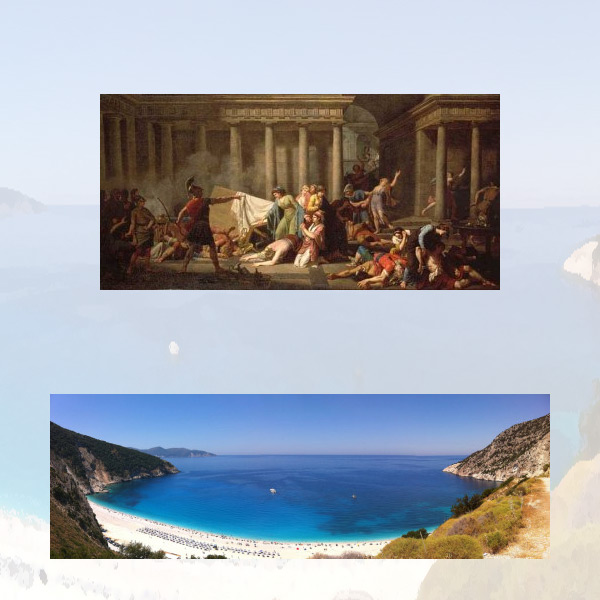The Mystery named Kefalonia

Rarely, can remarkable beaches be matched together with high mountains and religious and archaeological monuments with beautiful settlements. The same stands true for combining folk culture with a sparkle same as that of Hollywood. Having as a “salt and pepper” the “craziness” of its residents, Kefalonia becomes a “plate” which is special, complete and more than satisfying.
Kefalonia is an island that charms with its contradictions. The biggest island in the Ionian sea and the 6th greatest of Greece (after Crete, Evia, Rhodes, Lesvos and Chios) is basically a mountainous island, where the volume of the mountain Ainos is dominating and which is the highest mountain of all Ionian islands (1628m) while having been announced as National park.
Kefalonia with the “Black Mountain” (Monte Nero was called by the Venetians) having the characteristic “black” firs (Abies Cepha- Ionica) is mostly well known for its impressive beaches which very often stand out in any type of social networking and electronic poll having as subject “The most beautiful beaches of the country” or even “….of the world” as well, just like the beaches of Petanon, Mirtou, Platias Ammou and Xi with the characteristic red sand and the clayey rocks.
Kefalonia is also known for some other “mysteries”, like the Katavothres, the Melisanis cave and Kounopetra.
What if it is the Odysseus island?
Most of the island’s visitors being astonished by its natural beauties, unfortunately bypass the important archaeological places. The ancient “signs” are traced back to the Paleolithic years, with most significant findings being discovered at the Drakaina’s cave, at Poro’s canyon that prove the human presence at least 6.000 years before Christ’s birth. Acropolis ruins, cyclopean walls and Mycenaean cemeteries exist being scattered at the whole island. According to Thucydides, Kefalonia is already since the 5th century b.c was divided into city-states. It had though 4 such city states as it is proven by the findings. Kefalonia had flourished even earlier than Thucydides times.
The most significant discovery was made recently and specifically in 1992 by the archeologist Lazarus Kolona, who discovered in Tzannata of Poros an arched tomb of the Mycenaean period which is considered to be the biggest and the best maintained tomb of that type in all the Western and Northern Greece. These findings serve as signs of a strong Mycenaean centre at the island and lead many archeologists to the formulation of an apparent “irrational” question: Is Kefalonia, the Ithaca of Homer? Some archeologists look for the Odysseus palace in the south-eastern end of Kefalonia between Poros and Skala and some others at the west at Paliki's peninsula.
Additional arguments in favor of those who support these theories is the fact that the first resident who gave the name to the island was named Kefalos, who is claimed to be the grandfather of Odysseus, while according to Homer the resourceful hero was the leader of the “generous residents of Kefalonia”. Of course, the Ithaca residents do not want even to hear a word for non-association of the contemporary Ithaca with the Ithaca of Homer.
Two urban centers fight with each other
Peace and solidarity seem to be words unknown for the ancient cities of Kefalonia, which had most of the time hostile relationship with each other. Usually, the echo of this “tradition” reaches also our times. A point that makes Kefalonia different from the other Ionian islands is the existence of two urban centers of Lixouri and Argostoli that act competitively. Until the middle of 18th century, when Lixouri had been already a developed city, Argostoli was just a small settlement, that was next to the sea and the castle of Saint George of the old capital.
The decision of the Venetians to move the capital from the castle to the small and unknown until then Argostoli in 1757 due to its central position and the safe natural port, made the residents of Lixouri furious. The emotions were mutual for both sides. The competition was fatly burst with Argostoli being dominant in the commercial and economics sector and Lixouri to take the lead in arts, education and the innovative at that times art of politics.
It may be today that this competition is decompressed by jokes and funny rhymes. Apart from the two cities, the residents are scattered to hundreds of villages. Some people count them to be 365 just like the number of days within a year! Their names come most of the time from family names plus the characteristic suffix “–ata”, a fact that might mean that the residents of Kefalonia couldn’t be peaceful even within the same family. That is the reason why they selected each family after being split to choose another area to live to, giving to that area their name as a way to characterize where that other members of a family resided. Each family and another village!



